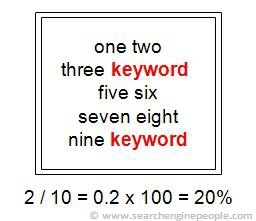Keywords and Keyword Density
 The subject of Keywords & Keyword Density is a talking point amongst SEO gurus worldwide and each has a different opinion of the right way to approach keyword density and how to deploy keywords throughout your content properly. The reason for the different opinions (and almost every SEO expert has his/her own opinion about the “right way” to do keyword optimizing) is that the ranking rules used by the Search Engines are a well kept secret. We honestly do not know an absolute way to use keywords the right way … we can really only guess.
The subject of Keywords & Keyword Density is a talking point amongst SEO gurus worldwide and each has a different opinion of the right way to approach keyword density and how to deploy keywords throughout your content properly. The reason for the different opinions (and almost every SEO expert has his/her own opinion about the “right way” to do keyword optimizing) is that the ranking rules used by the Search Engines are a well kept secret. We honestly do not know an absolute way to use keywords the right way … we can really only guess.
In the early days of the modern Internet (say, the mid-to-late nineties), the Search Engines used keywords and their keyword density within the content of a web page as a very important website ranking factors – that is, the more times a particular keyword or phrase appeared in the content of a website, the more likely that the website would rank well for a search of that keyword or phrase. If a web-page had an enormous number of instances of the word “Squirrels”, then the search engines made the decision “This website is about squirrels” and that website would rank very well when someone searched for “Squirrels”.
These days, keywords are not such important factors and have fallen behind the significance of a large number of inbound links to your site but keywords remain a factor none-the-less. In fact, a great deal of your S.E.O. efforts revolve around keywords; they are truly the foundation of any SEO work that you do.
However, your understanding and ability to calculate your keyword density is very useful for your work as an SEO marketer. It will allow you to make informed decisions about the content on your website and how to manipulate and optimize it for better ranking in the search engines.
There are automated tools for calculating keyword density it’s always best to understand the inner workings of keyword density, so you can make decisions about how to structure your content for yourself.
About Keyword Density
 Keyword density is the percentage of times a keyword or phrase appears on a web page compared to the total number of words on the page.
Keyword density is the percentage of times a keyword or phrase appears on a web page compared to the total number of words on the page.
Keyword density is a little bit of a tightrope walk. Too low a keyword density and your keywords will have little (or almost no) significance to your search engine ranking. Too high a keyword density and you may be penalized by the search engines for “keyword stuffing” (that is they will lower your placement in the search engine results pages because you have used a keyword way too many times for it to simply be a coincidence).
Many SEO experts consider the optimum keyword density to be 1% to 3% percent and Google documentation states that your keyword density for any keyword or phrase should be less than 5%. You must make your own decisions about what is right for you but it seems like a keyword density of around 2%-3% is just right.
Here I am going to show you how to calculate your keyword density and help you optimize your website. There will be a little bit of mathematics involved but nothing more complicated than a little multiplication and division. How you calculate your keyword density relies heavily on the circumstance in which you are using your keywords.
Keyword Density: The Maths!
 To calculate keyword density in its simplest form, you divide the number of times that you have used a specific keyword by the total number of words in the text that you are analyzing and multiply the result by one hundred to achieve your percentage.
To calculate keyword density in its simplest form, you divide the number of times that you have used a specific keyword by the total number of words in the text that you are analyzing and multiply the result by one hundred to achieve your percentage.
Therefore:
Keyword Density = (Nkr / Tkn) x 100
Where:
Density = your keyword density
Nkr = how many times you repeated a specific keyword
Tkn = total words in the analyzed text
So, if your article or piece of content (the text you are analyzing) is 500 words in length and you have used your keyword 15 times, the keyword density for that keyword is…
Keyword density = (Nkr / Tkn) x 100
= (15 / 500) x 100
= 0.03 x 100
=3
Keyword density = 3% !!!
That’s pretty straight-forward, huh?
POP-QUIZ!
If I have an article that is 2000 words in length and I have used the keyword “squirrel” 120 times, what is the keyword density for the word “Squirrel”? – What do you think; is this too much or too little? Will I be penalized by Google for Keyword Stuffing?
About Key-Phrases
Key-phrases add a new level of complexity to the keyword density issue. People don’t only search for one word when they perform searches on the internet. They may use a phrase which contains more than one word. Users will search terms that contain more than one word usually because they are looking for something specific.
If I were in search of a great waffle-house in my area (believe me, not such a crazy idea) I wouldn’t just search the keyword “waffles” in Google… This would return me a list of millions of results. I would instead search something like “waffles in Delaware”. “Waffles in Delaware” is an example of a key-phrase because it consists of more than one word as opposed to a keyword which is a single word.
So, someone trying to cater to my search would possibly try and optimize their content for that key-phrase – “Waffles in Delaware” and they would try and fine-tune the density of the key phrase to that coveted 1% – 3% range.
This changes the calculation that we must perform to calculate our keyword density, because now we are dealing with an entity that contains multiple terms.
This presents an interesting dilemma. To work out the keyword density of a key phrase, it could be tempting to use:
Density = (Nkr x (Nwp / Tkn)) x 100
Where:
Density = your keyword density
Nkr = how many times you repeated a specific key-phrase
Nwp = number of words in your key-phrase
Tkn = total words in the analyzed text
So, again, if we take my “Waffles in Delaware” example – There are three words in my key-phrase and I have used that key-phrase three times amidst my total word count of 500 words.
Density = (Nkr x (Nwp / Tkn)) x 100
= (3 x (3 / 500)) x 100
= (3 x 0.006) x 100
= 0.018 x 100
Density = 1.8%
There is a problem with this keyword density formula, however. One cannot ignore the fact that keyword density refers to the frequency of the appearance of one particular keyword. This means that “Waffles in Delaware” should be counted as if it was just one word amongst the rest of your text and not three words.
This idea brings us back to our original formula, Keyword Density = (Nkr / Tkn) x 100, and doing the calculation above gives us:
=(3 / 500) x 100
=0.006 x 100
=0.6%
which is a little low and very different. If you were using this formula to calculate your keyword density, you would want to add a few more instances of “Waffles in Delaware”
Furthermore, if you think about it, these key-phrases that consist of more than just one word artifically inflate the total word count of your text and as such it can be further argued that the total word count of your analyzed text should be adjusted by removing the excess key-phrase words from the total . From this we can derive the ultimate Keyword density formula :
Density = ( Nkr / ( Tkn -( Nkr x ( Nwp-1 ) ) ) ) x 100
Using this formula, we can see that our keyword density for the key-phrase “Waffles in Delaware” is too low if we only use three instances of “Waffles in Delaware”.
Let’s imagine then that we upped-the-ante and now use the key-phrase “Waffles in Delaware” nine times, instead of just three:
= (Nkr / (Tkn – (Nkr x (Nwp – 1)))) x 100
= (9 / (500 – (9 x (3 – 1)))) x 100
= (9 / (500 – (9 x 2))) x 100
= (9 / (500 – 18)) x 100
= (9 / 482) x 100
= 0.0186721991701245 x 100
= 1.87%
That is better and within the safe keyword density to use.
This formula allows for a simple one-word keyword as well as for key-phrases which consist of as many terms as you like and as such it acts as the original formula.
Useful Tools
There are several online tools to help you calculate your keyword density. My favorite is live-keyword-analysis.com. It’s really simple to use. Just pop in the text you are analyzing and the software will give you percentage values for your keywords and –phrases.
It’s also really interesting to have a look at some of the “rules” that this tool uses to examine keyword density (which can be found here: live-keyword-analysis.com/keyword_analysis_rules.html). You will note, for example, that this keyword tool does not count any one or two letter words as well as certain html tags.
This MAY be something akin to the way that Google or Yahoo! view keyword densities or part of the algorithm they use in their ranking criteria. In truth we will never really know … As this website itself points out: “when is search engine optimization ever ultra precise?”
Please also visit the links below to try them out. You can use the formulas above to decide how these online tools are calculating your keyword density to decide if they are useful to you.
http://www.seomastering.com/keyword-density-analyzer.php
http://seotools.seozy.com/tools/keyword-density-checker/
http://www.seobay.com/tools/keyword-density-checker/
http://www.seocentro.com/tools/seo/keyword-density.html
http://seochat.com/seo-tools/keyword-density
http://www.webconfs.com/keyword-density-checker.php
http://www.webcaretech.com/search-marketing/search-engine-optimisation/
Keyword Density vs. Quality Content
Aww, c’mon; that’s an easy one … Quality Content each and every day!
I mentioned earlier that keyword density is not that great of a ranking factor these days.
The real SEO power of your website is its ability to get your visitors enjoying and linking to your content. Take this article for example … I haven’t used a keyword formula once while I was writing it.
Always remember that keywords are secondary to the quality of the content that you offer your visitors. Make it compelling, make it interesting and make it useful … Then go back and optimize your keyword density if you feel that it should be modified.
If I were to propose a formula for S.E.O., it may be something like this:
S.E.O. = High Quality Content + Loads of Inbound Links + [just a little keyword optimizing (if required)]

